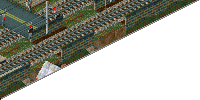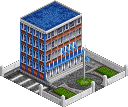|
Strategy
Rail Networks: Terminus station layouts
Terminus stations are one-sided stations. Trains both enter and exit from the same side of the station.
These stations are useful when space is tight - they are cheaper, but much slower. This is because
only one train can use the entrance tracks at once, forcing the trains to wait for both entering and leaving
trains. This can cause delays.
Below is the basic layout of a terminus station.

Signals next to the station must be two-way signals or you will experience problems. Use single direction
signals to show which way the train must enter and leave the station.
Whilst maintaining the same system, there are varying ways that you can lay out the track leading to your
terminus station. Below I have explained some of the best, although there are other designs which work
just as well. Please note that these names are just made up, and are not necessarily what others in the
community may refer to them as!
The Claw

This style of track is easy to build but requires extra space around the station. If you only have room to
approach the station from the front, then this style will not work. If you can approach from the side,
however, it can be very effective. This layout can be easily expanded to allow more platorms. Trains leave
in the opposite direction that they entered, but this can be changed using the Double Claw, below.
The Double Claw

The track in this setup may look more cluttered, but enables you to let the trains approach and exit in the
same direction. You can use any 2 types of curve in this layout, although the bigger ones work best due to
speed limits. This layout can be easily expanded to allow more platorms.
The HXY Layout

This layout is named from the construction segments you use to create it. The junction allows a train to
enter the station from the front and enter any platform it wishes without trouble. It is also quite compact
but does not allow much room for expansion. If you try to make more than 4 platforms, things become much
more complex and messy. Below you can see the 3 segments that make up the junction. Note: some bits will
overlap, but I've included them all for the sake of a nice picture.

Thanks to all the people who sent pictures and comments. They were helpful in making this page.
Click here to return to the rail networks index.
|








